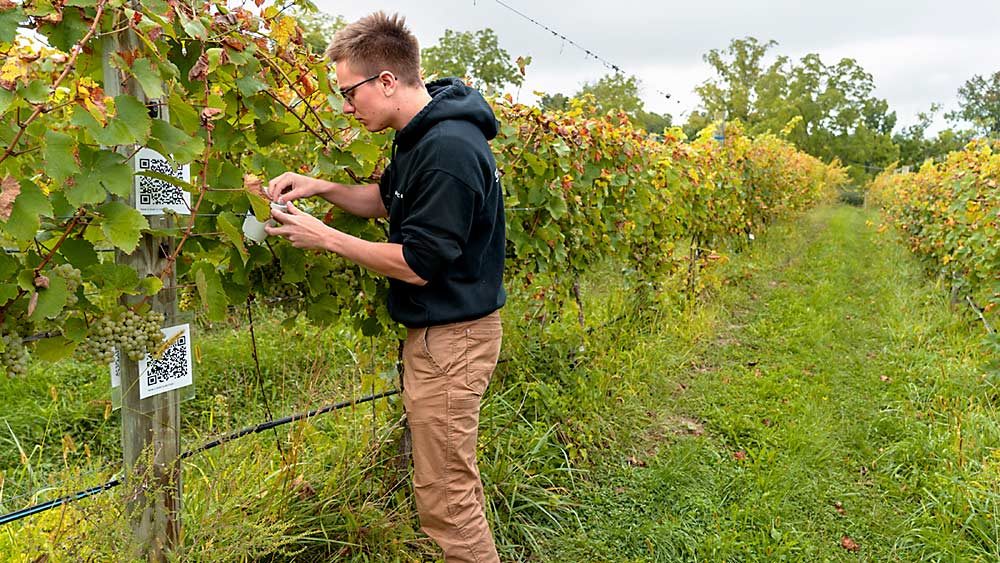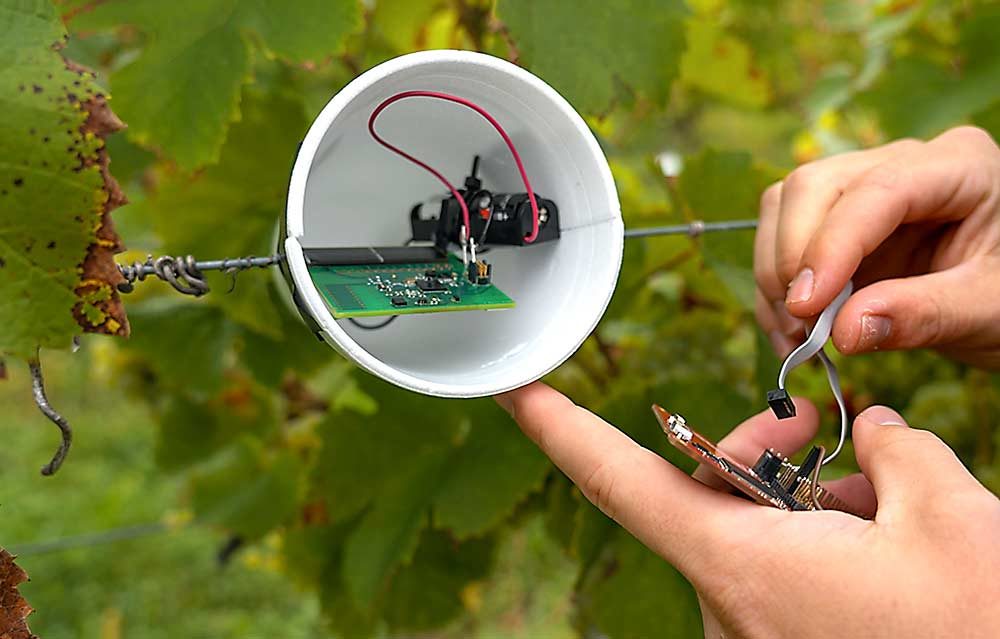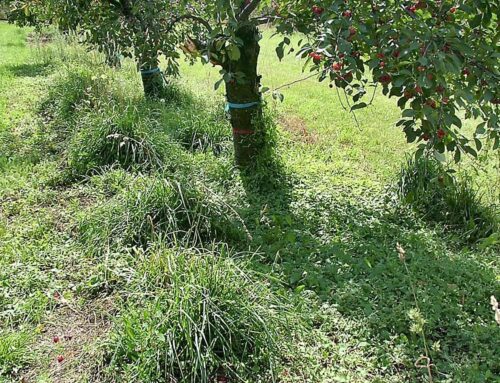
While testing tiny satellites meant for space exploration, Hunter Adams realized they could be useful in terrestrial vineyards as well. “The data from these things might be actionable and valuable,” said Adams, who recently earned a doctorate in aerospace engineering from Cornell University. “That’s what led me from space to agriculture.”
The basic idea is to shrink satellites to the smallest size possible and deploy them over a large area in space where, as a network, they can gather at least as much data, if not more, than a conventional satellite. The microsatellites Adams and his research group have been designing, building and testing are basically printed circuit boards that can fit in the palm of your hand — like the kind you can find in any cellphone or laptop. The technology is cheap and easy to replicate.
The researchers ultimately want to deploy the microsatellites, which Adams calls Monarchs, on the surfaces of other planets or moons within the solar system. The researcher decided that as long as he needed to take planetary measurements, however, he might as well use the planet closest to hand: Earth. While he was searching for useful terrestrial applications for the small satellites, some of his Cornell colleagues pointed Adams toward agriculture.
Adams started placing Monarchs in New York state vineyards in spring 2019, after consulting with vineyard managers to determine which sensors would be most beneficial. He added temperature and humidity sensors for vineyard uses, but the Monarchs also measure ambient light, GPS location, their own motion and the magnetic field. The data could help growers make vineyard maintenance decisions, such as spray scheduling. If more accurate data can translate into fewer chemical sprays per season, the microsatellites will do growers the ultimate favor: save them money.
He deployed the microsatellites at two locations in the Finger Lakes region: Anthony Road Wine Co. in Penn Yan, on the west side of Seneca Lake; and a Cornell teaching vineyard in Lansing, on the east side of Cayuga Lake. He placed 20 microsatellites in each vineyard. Each Monarch carried a tiny radio, which communicated with an antenna placed near the vineyard.
Adams learned an important early lesson — waterproofing — at the first vineyard. Rain destroyed the exposed Monarchs after about a week. Moreover, direct sunlight made temperature readings artificially high.
On his second attempt, Adams found a simple solution to the exposure problem: Styrofoam cups. Placing each microsatellite inside a cup protected it from water and kept it shaded, allowing it to take more accurate temperature readings.
“It’s not the most professional-looking solution,” he said with a chuckle, “but the cup worked wonderfully.”

Data-based
Peter Martini, vineyard manager at Anthony Road Wine Co., said the Monarchs’ sensors provide real-time data that can be used to observe potential microclimatic differences within blocks of grapes — information that can help implement more precise disease-control responses.
The Finger Lakes is a cooler climate region with wide fluctuations in temperature and variable precipitation. Even in a single vineyard, temperatures can differ as much as 7 degrees Fahrenheit between the top and bottom of a hill. There are weather stations in the region, but they don’t always meet a specific vineyard’s needs or capture the microclimates created by vineyard canopies. Multiple microstations distributed throughout each canopy can produce more fine-grained climate data applicable to an individual vineyard, Adams said.
Both test vineyards had conventional weather stations on site, allowing Adams to compare their results to that of the Monarchs. He ended up measuring temperature differences of 5 or 6 degrees F in some areas — a more accurate reflection of what’s going on inside those microclimates, he said.
“The Monarchs are exciting because they bring the ability to understand the environmental conditions at much greater spatial resolution, compared to a standard weather station,” said Justine Vanden Heuvel, a Cornell viticulture professor who helped Adams interpret his vineyard data. “This information could be really helpful in making better management decisions around spraying and other practices.”
Adams said the Monarchs also can give earlier and more specific indications of frost, a big concern in the Finger Lakes region.
“Frost flows like viscous fluid,” he said. “Cool air will settle in a depression. The satellites can detect it there and growers can take earlier action.”
Overall, Adams was pleased with the results from the first season of testing the Monarchs in vineyards. The infrastructure in the two locations remains in place, so the microsatellites can be redeployed there. He also has applied for federal grants to pay for the next step: buying hundreds of Monarchs (he sends his special design to a commercial manufacturer) and deploying them around the Finger Lakes. He thinks the Monarchs have potential in apple orchards, too.
As for the original mission — getting the microsatellites into space — there’s a plan to launch some in a rocket manufactured by Blue Origin, the aerospace company owned by billionaire Jeff Bezos, in early 2021. The devices will be deployed at the edge of space, where they will gather atmospheric data.
“We’ve learned a lot about gathering data from large collections of these things,” Adams said. “That will be useful for all these space activities. The vineyards allowed us to develop techniques for doing that.” •
—by Matt Milkovich






Leave A Comment